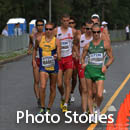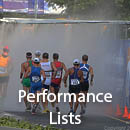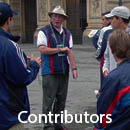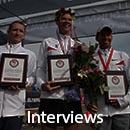IAN WHATLEY
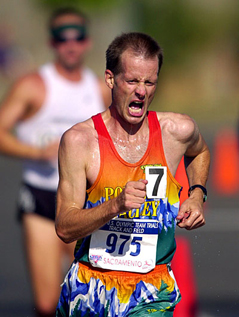
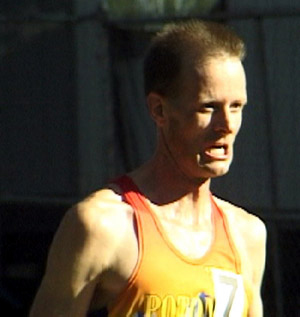
Birthday: May 8th, 1959
Current Residence : ???
Hometown: ???
College: ???
PRS
Outdoors
20 km - 1:27:02
50 km - 4:14:48
Whatley has been a member of the following US national teams: Indoor 3,000 M (1993 Vs. Great Britain), Outdoor 10 Km track pre-Olympic meet (Atlanta,1995), 20 Km road - World cup (Mexico, 1993) and 50Km road - Pan-Am cup (Brazil, 1996)
He competed in the following US Olympic trials: 1992 (7th at 20K), 1996 (5th at 50K and DNF at 20K), 2000 (7th at 20K)
PERSONAL
Whatley attended King Edward VI School, Birmingham and Loughborough University in Britain where he ran steeplechase and cross country, including captaining the British universities team. Due to a severe bout of mononucleosis and stress fractures in both legs, he was unable to run for a year and used racewalking to maintain fitness, winning the bronze in the British Universities 3,000M at the national championships. In 1981, Whatley was brought to the US on a unique skills visa by Nike to set up an applied sciences section of their sport research lab. After several years as a good but not great road runner, Whatley visited Korea on business at the time of the 1988 Olympics and was inspired to train seriously for the walks. In conjunction with physiologists Mitch Craib and Jack Daniels, Whatley adapted the then most current theories of running training to racewalking with excellent results.
Whatley retired from top level competition in 1996 and 2000 due to problems with an ongoing lawsuit against Nike. He expects to retire again in 2004 and 2008. He currently teaches occasional clinics on the sport science basis for racewalk training. A video tape of his lectures and track sessions from a 2003 US national junior camp are soon to be made available.
TRAINING
Whatley trained with two annual cycles of about equal length, geared to peak performances in late spring and fall. Each cycle consisted of 3 to 6 week blocks at constant workload set according to race results in the previous month. Each week included 3 hard track sessions and a long walk of 13 to 18 miles on the hilly roads around Clemson in South Carolina. Total weekly mileage was rarely more than 100 miles and most often in the 50-60 mile range with high intensity rather than high volume as a focus. Phase one included a large volume of short reps; bends and straights or 80 to 100 meter repetitions with long recovery. These were designed to improve efficiency of movement at race speed with good technique. Longer reps with short recovery, such as 12 X 200 with 1 minute rest, were done to improve lactate clearance from working muscles.
Phase 2 introduced two sessions a week of walking at or close to maximum Oxygen uptake walking pace. Examples were 5 X 5 minutes with 5 minutes rest or 8 X 800 M at target pace with 3.5 minutes rest. The third weekly session was either a race or a 5K track time trial followed by 12 X 200 with 1 minute rest between. Target paces for all sessions were set using Jack Daniels VDot tables for runners and ignoring race results shorter than 5K. (See Daniels' Running Formula. Human Kinetics Press)
Phase 3 replaced the VO2 max sessions with workouts at lactate threshold pace, again set using the Daniels' VDOT tables and recent race results. Examples would be 5 X 10 minutes at target pace with one minute recovery between reps. The third session of the week was again a race or time trial followed by short recovery 200 reps.
Phase 4 was racing phase in which total walking distance per week was cut to 40-60% of previous levels. A six day taper was used, covering 6 X 400M at lactate threshold with 1 minute between each on the first day, cutting down one rep per day until race day. All sessions of the taper were done with short warm ups and cool downs of not more than 800 M each and carried out at the same time of day as the upcoming race. In the none race weeks, most work sessions were at threshold pace followed by 4 to 6 200M reps with short recovery.
Whatley avoided running as a part of his training due to an habitually high knee action that upset his RW form. He still managed to silence local critics of racewalking in South Carolina with a 4.19 mile run in 1994.
ADVICE
(Sage comments from the old geezer)
- Work with a coach and set a long term goal. Choose short term actions that will advance you to that goal.
- You will be disqualified at some stage in your career. Rehearse your response so you don't upset the judges or look like a jerk. Shake hands with the chief judge, take off your number and leave the area without saying anything on the subject to anyone until you have cooled off from the inevitable emotions you will be feeling. If you can't say anything nice, shut up on the subject - it won't make you look good and may cause some judges to inspect your form more closely in future events.
-
Spend more time training and thinking than thinking about training.
- Don't look too closely at the workings of USATF or the racewalk committee. Like seeing the making of laws or sausages, it will not do your confidence any good.
- Don't get caught up on fads and complexity. Our event is simply a test to see who can go fastest from A to B while abiding by 2 rules.
2000
9th - 1:32:26
1996
9th - 1:27:18
1993
9th - 1:28:04
1992
6th - 1:27:02
1996
5th - 4:14:48
None
1992
Two Hour - 25,092 meters
20K World Cup
1993 – 65th – 1:36:53– Monterrey, Mexico
50K Pan Am Cup
1996 – 11th – 4:58:50– Manaus, Brazil
